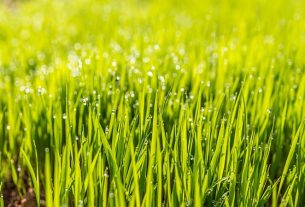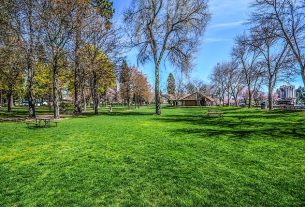Implementing a seasonal lawn mowing schedule is crucial for a thriving lawn, as it promotes healthy root growth, deters weeds, and maintains grass vigor throughout the year. During the growing season, set your mower to cut only a third of the grass height at its highest setting to encourage deep roots and a dense turf that naturally repels pests and weeds. As fall transitions into winter, lower the cutting height progressively to prepare the grass for the cold and ensure a quick bounce-back in spring. Regular mowing, particularly in autumn to break down leaves, is essential to prevent lawn smothering and maintain soil-grass contact for nutrient uptake. Additionally, understanding and maintaining the right soil pH and composition are vital for a healthy garden, as they affect water retention, nutrient accessibility, and overall plant support. Regular soil testing and adjustment are recommended to keep your lawn and garden balanced and thriving. By adhering to these seasonal practices and focusing on lawn care and landscaping, you can cultivate a verdant yard that stands out as a neighborhood gem, reflecting a well-maintained landscape year-round.
Embark on a journey through the lush greenery of well-tended gardens and the serene beauty of expertly designed outdoor spaces. This article serves as your guide to mastering lawn care and landscaping, transforming any yard into a vibrant canvas that captivates the senses and enhances your home’s curb appeal. From understanding the nuances of soil composition to crafting a landscape that blends both form and function, learn the essential practices for maintaining a thriving lawn and the design principles that elevate your garden to an art form. With a focus on sustainable and low-maintenance solutions, you’ll discover how to create a landscape that not only looks stunning but also promotes ecological harmony. Dive into the world of Lawn Care and Landscaping, where every blade of grass and bloom tells a story of care and creativity.
- Essential Practices for Vibrant Lawn Care
- – Understanding Soil Composition and pH Levels for Optimal Growth
- – Seasonal Mowing Techniques to Promote Healthy Grass Development
Essential Practices for Vibrant Lawn Care

A vibrant lawn serves as a welcoming green space that enhances both the aesthetic appeal and the value of your property. Effective lawn care and landscaping practices are pivotal for achieving this lush environment. Regular mowing at the correct height, which typically is about one-third of the grass blade’s length, encourages root growth and deters weeds. Aeration is another crucial practice that helps alleviate soil compaction, allowing air, water, and nutrients to penetrate the soil more effectively, promoting a robust and resilient lawn. Fertilization should be tailored to your local soil type and grass variety, ensuring you provide the necessary nutrients at optimal times for sustained growth. Additionally, proper irrigation systems are essential for maintaining moisture levels without over-saturating the soil. A well-designed landscaping plan, integrating a variety of plants, shrubs, and trees, complements your lawn care efforts by creating a harmonious outdoor environment that is both beautiful and sustainable. Regular maintenance tasks such as removing thatch, raking leaves, and managing pests and diseases proactively will further contribute to a healthy and thriving landscape. By implementing these lawn care and landscaping practices with diligence and care, you can enjoy a vibrant, green space that is the envy of the neighborhood.
– Understanding Soil Composition and pH Levels for Optimal Growth

Maintaining a vibrant garden requires a deep understanding of the soil in which your plants are rooted. Soil composition plays a pivotal role in supporting plant life, influencing everything from water retention to nutrient availability. For optimal growth, it’s crucial to assess and adjust the soil’s makeup as needed. A balanced soil composition typically consists of organic matter, minerals, water, air, and microorganisms, all of which contribute to a healthy growing environment.
In conjunction with evaluating soil composition, lawn care professionals emphasize the importance of understanding and maintaining the correct pH level in your garden’s soil. The pH scale measures the acidity or alkalinity of the soil, ranging from 0 to 14. Most plants thrive at a slightly acidic to neutral pH, with values between 6.0 and 7.5 being ideal for a variety of plant species. Adjusting the pH can enhance nutrient uptake and overall plant health. To tailor your garden’s soil for maximum plant performance, consider conducting regular soil tests. These tests will inform you of both your soil composition and pH levels, allowing for precise adjustments with the right amendments. Engaging in such practices as part of your lawn care and landscaping routine can significantly improve the vitality and aesthetics of your outdoor spaces.
– Seasonal Mowing Techniques to Promote Healthy Grass Development

Engaging in seasonal mowing is a fundamental aspect of lawn care that significantly influences grass health and development. During the growing season, typically late spring through early fall, it’s crucial to adjust cutting heights to promote deep root growth and enhance grass resilience. Mowing at the highest setting during these months allows for the removal of only one-third of the leaf blade at a time, which minimizes stress on the lawn. Regular, consistent mowing at this height encourages a dense turf that outcompetes weeds and pests, while also improving soil-grass contact for nutrient uptake.
As seasons change, so should your mowing strategy. In the fall, gradually lower the mower to prepare the grass for winter dormancy. This encourages the grass to grow stronger blades that can withstand colder temperatures and rebound quickly in the spring. Additionally, removing fallen leaves by mowing them into small pieces helps prevent a layer of debris that could smother the lawn. By adhering to these seasonal mowing techniques, your landscaping efforts will yield a lush, healthy lawn that is both aesthetically pleasing and environmentally resilient. Proper lawn care and attentive maintenance throughout the year ensure that your landscape remains a verdant oasis regardless of the season.
In conclusion, maintaining a lush and vibrant garden not only elevates the aesthetic appeal of your outdoor space but also fosters a healthy ecosystem. By implementing the essential practices outlined in our discussion on lawn care and landscaping, such as tailoring your soil management to enhance composition and pH levels, and employing seasonal mowing techniques that encourage robust grass development, you can achieve a flourishing garden that stands as a testament to meticulous care and attention. Remember, the art of lawn care and landscaping is an ongoing journey, one that requires patience, adaptability, and a commitment to continuous learning. As you cultivate your green space, let it be a reflection of your dedication to beauty and balance in nature.



